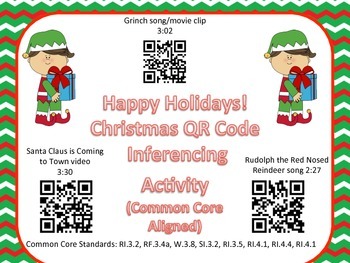Christmas QR code Inferencing 3-5 (Common Core Aligned)
PreK-12 Instructional Coaches Corner
187 Followers
Grade Levels
3rd - 5th
Resource Type
Standards
CCSSRL.4.1
CCSSRL.4.5
CCSSRI.3.2
CCSSRI.3.5
CCSSRI.4.1
Formats Included
- PDF
Pages
19 pages
PreK-12 Instructional Coaches Corner
187 Followers
Description
This activity consists of a series of questions about Christmas.
Each clue describes the following :
1-Christmas Lights 2- Artificial Christmas Tree 3-Candy Canes
4- Jingle Bells 5- Black Friday Shopping 6- Christmas Island
7- Rudolph 8- Elves 9-Ornaments 10- Christmas Cards
11-Salvation Army Kettle Campaign 12-Reindeer 13-North Pole
14-Christmas Cookies 15-Elf on a Shelf
The QR codes are linked to non-fiction Wikipedia articles. This is a great way to connect literature to History/holiday topics while incorporating technology. This activity requires the students to read the clues and make an inference. They will then scan the QR code and read the article to pull out 2 more interesting facts about each topic. This is a wonderful way to promote CLOSE reading.This would be great to use during Daily 5 or center time or can be used as a homework assignment. These are designed to be used in public school so they are In no way connected to any religion. (That’s why Santa is not included) Make sure that you have a QR code scanner that brings you directly to the URL. The QR code for iPad (free) works great. There are also multiple apps available both in the iTunes App Store or Google Play store.
Please make sure that if your codes are not working at school that you check with your IT person to make sure that Youtube is not blocked at your school.
Please make sure to leave me feedback:)
Happy Teaching! Druvenga’s Pride
Each clue describes the following :
1-Christmas Lights 2- Artificial Christmas Tree 3-Candy Canes
4- Jingle Bells 5- Black Friday Shopping 6- Christmas Island
7- Rudolph 8- Elves 9-Ornaments 10- Christmas Cards
11-Salvation Army Kettle Campaign 12-Reindeer 13-North Pole
14-Christmas Cookies 15-Elf on a Shelf
The QR codes are linked to non-fiction Wikipedia articles. This is a great way to connect literature to History/holiday topics while incorporating technology. This activity requires the students to read the clues and make an inference. They will then scan the QR code and read the article to pull out 2 more interesting facts about each topic. This is a wonderful way to promote CLOSE reading.This would be great to use during Daily 5 or center time or can be used as a homework assignment. These are designed to be used in public school so they are In no way connected to any religion. (That’s why Santa is not included) Make sure that you have a QR code scanner that brings you directly to the URL. The QR code for iPad (free) works great. There are also multiple apps available both in the iTunes App Store or Google Play store.
Please make sure that if your codes are not working at school that you check with your IT person to make sure that Youtube is not blocked at your school.
Please make sure to leave me feedback:)
Happy Teaching! Druvenga’s Pride
Total Pages
19 pages
Answer Key
N/A
Teaching Duration
N/A
Report this resource to TPT
Reported resources will be reviewed by our team. Report this resource to let us know if this resource violates TPT’s content guidelines.
Standards
to see state-specific standards (only available in the US).
CCSSRL.4.1
Refer to details and examples in a text when explaining what the text says explicitly and when drawing inferences from the text.
CCSSRL.4.5
Explain major differences between poems, drama, and prose, and refer to the structural elements of poems (e.g., verse, rhythm, meter) and drama (e.g., casts of characters, settings, descriptions, dialogue, stage directions) when writing or speaking about a text.
CCSSRI.3.2
Determine the main idea of a text; recount the key details and explain how they support the main idea.
CCSSRI.3.5
Use text features and search tools (e.g., key words, sidebars, hyperlinks) to locate information relevant to a given topic efficiently.
CCSSRI.4.1
Refer to details and examples in a text when explaining what the text says explicitly and when drawing inferences from the text.





